Inpatient census 2018: parts one and two
Results of the fourth Mental Health & Learning Disability Inpatient Census and Out of Scotland NHS Placements Census, 2018.
This document is part of a collection
1. Overview of patients being treated in NHS Scotland facilities
- 3,443 mental health, addiction and learning disability inpatients in NHS Scotland at the 2018 Census
- 58% of patients were male, higher than the general population (49%)
- The bed occupancy rate in NHS Scotland was 84% at the 2018 Census though this ranged from 55 - 100% depending on ward type
Number of patients and available beds, by NHS Board and ward type
There were 3,443 inpatients being treated in NHS Scotland facilities at the 2018 Census, a 4% decrease compared with the 2017 Census. Table 1 shows the number of mental health, learning disability and addiction inpatients being treated in each NHS Board across each Census carried out to date. The number of inpatients has decreased each Census, with a 12% decrease from the first Census in 2014 to the most recent in 2018.
Note that NHS Grampian, NHS Greater Glasgow & Clyde, NHS Lothian and NHS Tayside contain Regional Units which provide services to patients from other NHS Boards. NHS Fife also provide a low secure Learning Disability Regional Unit for the treatment of patients from other boards. NHS Orkney and NHS Shetland do not have any mental health, learning disability or addiction inpatient beds; their patients are treated by other health boards or other healthcare providers on their behalf.
Table 1: Number of patients, by NHS Board and Census
| NHS Board of treatment | 2014 Census | 2016 Census | 2017 Census | 2018 Census |
|---|---|---|---|---|
| NHS Ayrshire & Arran | 198 | 184 | 192 | 201 |
| NHS Borders | 59 | 45 | 50 | 53 |
| NHS Dumfries & Galloway | 77 | 49 | 55 | 55 |
| NHS Fife | 256 | 184 | 253 | 238 |
| NHS Forth Valley | 217 | 206 | 214 | 210 |
| NHS Grampian | 339 | 319 | 297 | 291 |
| NHS Greater Glasgow & Clyde | 1,105 | 1,111 | 1,002 | 937 |
| NHS Highland | 169 | 173 | 160 | 141 |
| NHS Lanarkshire | 346 | 312 | 301 | 269 |
| NHS Lothian | 670 | 596 | 611 | 603 |
| NHS Tayside | 334 | 322 | 312 | 325 |
| NHS Western Isles | 18 | 15 | 14 | 12 |
| State Hospital | 121 | 117 | 111 | 108 |
| Scotland | 3,909 | 3,633 | 3,572 | 3,443 |
There were 4,075 available mental health, addiction and learning disability beds in Scotland at the 2018 Census, a 3% decrease on available beds at the 2017 Census. The number of available beds has been decreasing each Census, with a 10% decrease from the 2014 Census to the 2018.
Table 2: Number of available beds, by NHS Board and Census
| NHS Board of treatment | 2014 Census | 2016 Census | 2017 Census | 2018 Census |
|---|---|---|---|---|
| NHS Ayrshire & Arran | 299 | 265 | 273 | 264 |
| NHS Borders | 65 | 57 | 63 | 63 |
| NHS Dumfries & Galloway | 107 | 85 | 85 | 85 |
| NHS Fife | 346 | 252 | 289 | 286 |
| NHS Forth Valley | 240 | 249 | 251 | 248 |
| NHS Grampian | 383 | 367 | 353 | 351 |
| NHS Greater Glasgow & Clyde | 1,176 | 1,154 | 1,128 | 1,061 |
| NHS Highland | 195 | 189 | 174 | 173 |
| NHS Lanarkshire | 450 | 440 | 411 | 393 |
| NHS Lothian | 711 | 645 | 649 | 639 |
| NHS Tayside | 409 | 402 | 380 | 379 |
| NHS Western Isles | 19 | 17 | 17 | 13 |
| State Hospital | 132 | 132 | 132 | 120 |
| Scotland | 4,532 | 4,254 | 4,205 | 4,075 |
The decrease in available mental health beds is a trend observed across other countries in Europe. According to Eurostat online data, the number of psychiatric care beds in the European Union has decreased from 73.4 per 100,000 population in 2010 to 72.0 in 2015. A decrease has occurred in 21 out of 28 European Union countries in this time period. The number of patients and beds per population in Scotland for each Census is presented in table 3 below.
Table 3: Available beds and patients per 100,000 population, by Census
| Measure | 2014 Census | 2016 Census | 2017 Census | 2018 Census |
|---|---|---|---|---|
| Available Beds per 100,000 pop | 84.7 | 78.7 | 77.5 | 75.1 |
| Inpatients per 100,000 pop | 73.1 | 67.2 | 65.8 | 63.5 |
The decline in available beds is observed in most ward types, though there are exceptions. The biggest decreases have been in addiction, continuing care/long stay and acute wards.
Table 4 shows the occupancy rates for different ward types across each Census. Due to definitional changes, a comparison with 2014 is not available. The majority of available beds are in acute wards, where occupancy was 86% at the 2018 Census.
Section 5 of this report presents statistics in more depth regarding services and patients by different ward types.
Table 4: Available beds & occupancy rates, by ward type and Census
| Ward Type | 2016 Census | 2017 Census | 2018 Census | |||
|---|---|---|---|---|---|---|
| No. Beds | Occupancy | No. Beds | Occupancy | No. Beds | Occupancy | |
| Acute | 1,543 | 87% | 1,525 | 88% | 1,331 | 86% |
| Intensive Psychiatric Care | 133 | 80% | 139 | 76% | 144 | 87% |
| Rehabilitation (non-addict) | 371 | 89% | 318 | 81% | 311 | 85% |
| Addiction Wards1 | 54 | 76% | 72 | 82% | 40 | 83% |
| Continuing care/long stay | 490 | 73% | 500 | 74% | 402 | 68% |
| Perinatal | 12 | 100% | 9 | 90% | 12 | 100% |
| Forensic (non-LD) | 382 | 90% | 391 | 88% | 410 | 90% |
| Forensic (LD) | 80 | 88% | 82 | 91% | 79 | 85% |
| Dementia Wards2 | 818 | 86% | 795 | 86% | 814 | 87% |
| Young People/Children3 | 50 | 96% | 54 | 70% | 54 | 98% |
| Learning Disability | 177 | 90% | 179 | 90% | 170 | 87% |
| Eating Disorder | 22 | 82% | 22 | 95% | 22 | 55% |
| Admission & Assessment | 173 | 89% | ||||
| Other | 134 | 84% | 128 | 84% | 113 | 76% |
| Scotland | 4,254 | 85% | 4,205 | 85% | 4,075 | 84% |
1 Addiction wards are the combination of addiction rehabilitation and addiction detox wards.
2 Dementia wards are the combination of dementia assessment and dementia care & treatment wards.
3 Young People/Children wards are the combination of Young people's units and children's units.
Note that hospitals in highly populated areas (e.g. NHS Greater Glasgow & Clyde and NHS Lothian) tend to have higher bed occupancy rates than rural areas. This is because it is easier for hospitals in close proximity to each other to move patients between facilities to maximise efficiency, whereas it is more important for rural hospitals to have spare capacity to accommodate an increase in the number of patients requiring an admission to hospital.
Annex A contains analysis of available beds for each NHS Scotland facility.
Reason for admission and admission from
The reason for admission for 1,279 (37%) patients was "Therapeutic/Clinical Crisis", while a further 442 (13%) of patients were admitted for "Diagnostic" reasons. Figure 1 shows a full breakdown of the different reasons for admission to the mental health and learning disability bed.
Figure 1: Number of patients, by reason for admission, 2018 Census
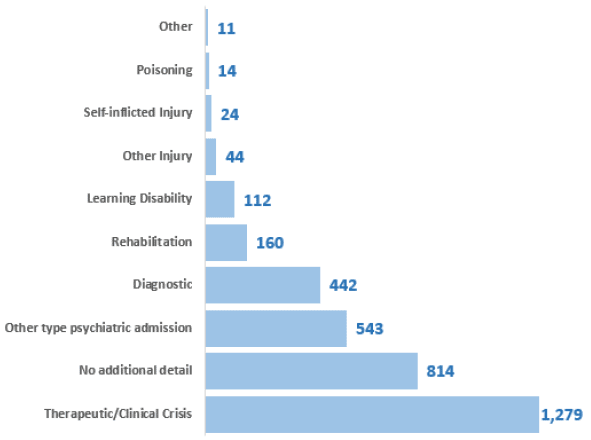
The majority of patients, 1,700 (49%), in the 2018 Census were admitted from a private residence, while a further 570 (17%) were admitted by transfer from the same NHS Board. There were 251 (7%) of patients who were admitted by transfer from another NHS Board. Figure 2 shows a full breakdown of where patients were admitted from.
Figure 2: Number of patients, by where admitted from, 2018 Census
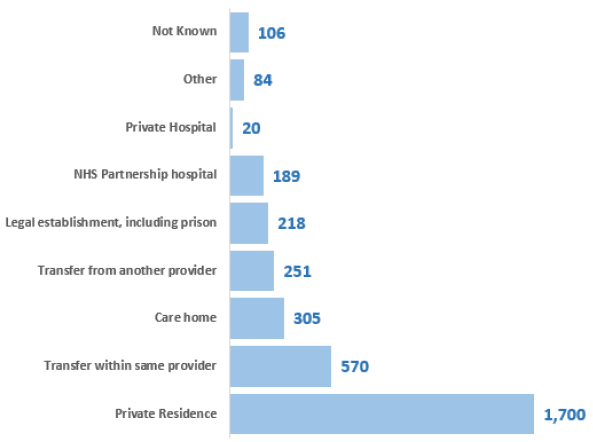
Length of Stay
The average (median) length of stay in a facility can have a large impact on the service provision of a ward. In those wards where patients have a long length of stay, there are less beds available for new patients coming in. The overall trend for length of stay has been decreasing in Scotland, with patients staying on average 24 days less in 2018 compared to 2014.
Table 5: Average (median) length of stay, by Census
| Measure | 2014 Census | 2016 Census | 2017 Census | 2018 Census |
|---|---|---|---|---|
| Average (Median) Days | 160 | 147 | 156 | 136 |
| Average (Median) Banded | 5.2 months | 4.8 months | 5.1 months | 4.5 months |
Boarding from another hospital
If a patient is "boarding" from another hospital, then they are staying in a hospital outwith their local catchment area. This could be because there were no beds available in a closer hospital or that their local hospital did not have the required services for the appropriate treatment of the patient.
A total of 39 patients were boarding in from another hospital at the 2018 Census. Of these, 29 (74%) were boarding to another hospital in the same NHS Board as their local catchment area. It should be noted even in cases where a patient is being treated in the same NHS Board, this can still involve large distances between the patient's home and the hosptial of treatment.
Table 6: Number of patients "boarding" from another hospital, by Census
| Measure | 2016 Census | 2017 Census | 2018 Census |
|---|---|---|---|
| Number of patients "boarding" | 55 | 38 | 39 |
| Number of patients "boarding" same NHS HB | 45 | 30 | 29 |
Ward Security Levels
Different wards have different levels of security. This can vary the level of unrestricted communcation patients are allowed or restrict visitors and the movements of patients. The majority, 2,515 (73%) of patients in the 2018 Census were in a "General Psychiatric Ward". There were 177 (5%) patients in a medium security ward and 126 (4%) in high security. The figures are similar to those observed in previous years.
There were 228 patients accepted for treatment in wards with a different level of security. Of these the majority (43%) were accepted for treatment in a low security ward, while 71 (31%) patients were accepted for treatment in a medium security ward.
Figure 3: Number of patients, by ward security level, 2018 Census
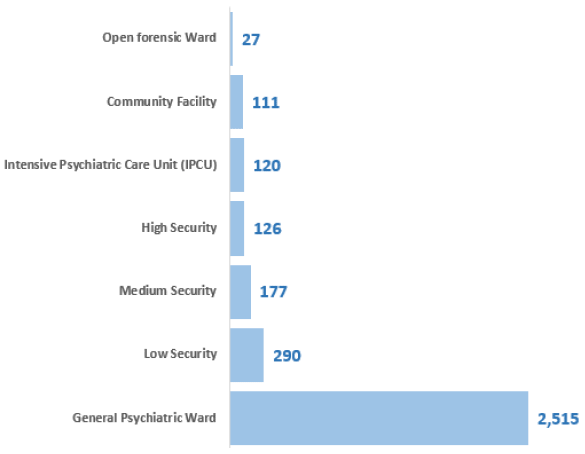
Observation level
As well as wards varying by security levels, individuals patients will also receive varying levels of observation depending on their individual level needs. This can impact on staff resources within a ward. Based on current guidelines the level of observation of patients at the time of the Census was recorded. The observation levels are:
- "General Observation" - Staff should have a knowledge of the patients' general whereabouts.
- "Constant Observation" - Staff should be constantly aware of the precise whereabouts of the patient.
- "Special Observation" - Patient should be in sight and within arm's reach of a member of staff.
- Enhanced care plan for therapeutic engagement - Aims to improve observation practice through therapeutic engagement with suicidal, violent or vulnerable patients to prevent them from harming themselves or others at times of high risk during their recovery.
The majority of patients, 3,190 (93%), were under general observation during the 2018 Census. Figure 4 shows the breakdown by observation level.
Figure 4: Number of patients, by observation level, 2018 Census
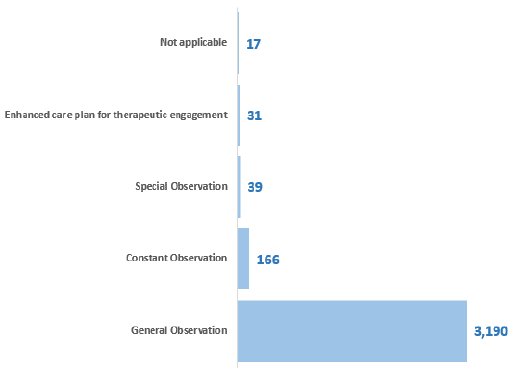
* Not applicable can relate to either patients being treated in care homes where an observation level may not apply, or patients on pass
For patients under Constant, Special or Enhanced Observation, further information on the number of staff involved in the observation was collected. Of the 236 patients under one of these observation levels, 47 (19%) had at least two members of staff involved.
The most common reason for a patient being on a Constant, Special or Enhanced Observation level was due to "risk of self-harm" (36%), followed by "risk of harm to others" (34%) and "risk of absconding" (17%). It should be noted that patients can be under observation for more than one reason, for example a patient may be under observation because they are a risk to themselves and others.
Figure 5: Number of patients, by reason for observation level, 2018 Census
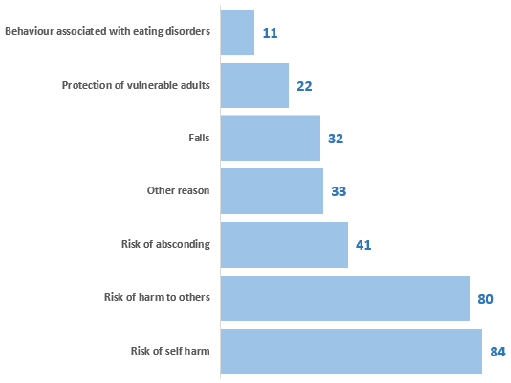
* Patients can have more than one reason for being on Constant, Special or Enhanced Observation
** Some reasons have been aggregated into "Other reason" due to small numbers
Status
Patients who have been detained under the provisions of the Mental Health (Care and Treatment) (Scotland) Act of 2003 are defined as having "Formal" status. "Informal" refers to voluntary Mental Health admissions.
There were 1,644 (48%) patients admitted with a "Formal" status in the 2018 Census, while at the time of the Census this had increased to 1,692 (49%) patients. The proportion of patients held under a "Formal" status at the Census point has been increasing annually, from 44% of patients in 2016 to 49% in 2018.
Other Legislation
NHS Boards returned data on a range of legislation for which patients were subject to at the 2018 Census. A total of 982 (29%) patients were subject to the Adults with incapacity (Scotland) Act 2000, while 898 (26%) patients were subject to the Mental Health Act (Compulsory Treatment Order). Data was missing for 263 patients.
Figure 6: Number of patients, subject to legislation, 2018 Census
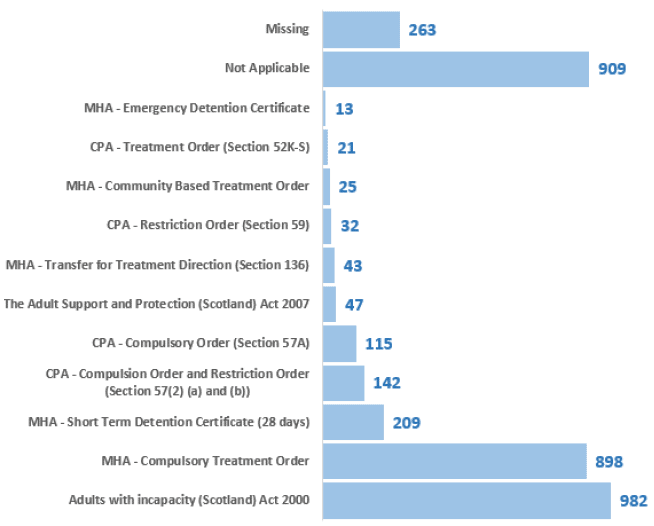
* MHA - Mental Health Act, CPA - Criminal Procedure Act
** Patients can be subject to more than one piece of legislation
*** Some data has been excluded for disclosure control
Hospital Based Complex Clinical Care
From 2016, the Inpatient Census collected information on patients receiving Hospital Based Complex Complex Care (HBCCC).
A patient is defined as receiving HBCCC if they have care needs that cannot be met in any setting other than hospital and require long-term complex clinical care, or have been in hospital for over 6 months. Under the definition of HBCCC, a patient cannot be a delayed discharge.
At the 2018 Census there were 731 (21%) patients receiving HBCCC who were occupying a mental health or learning disability inpatient bed, with 71% of these patients being treated in NHS Greater Glasgow & Clyde or NHS Lothian.
A separate, more detailed report on HBCCC will be published by the Scottish Government in late October 2018. This will cover HBCCC patients in mental health or learning disability inpatient beds, patients treated outwith NHS Scotland and patients in General Acute hospitals.
Delayed Discharge
Timely discharge from hospital is an important indicator of quality and is a marker for person-centred, effective, integrated and harm free care. A delayed discharge occurs when a hospital patient who is clinically ready for discharge from inpatient hospital care continues to occupy a hospital bed beyond the date they are ready for discharge.
At the 2018 Census, 258 patients were a delayed discharge. This is 8% of patients for which this information is known (information was not returned for 50 patients), the same proportion as 2017.
On Pass
Patients who are "On Pass" are still formally considered inpatients of a hospital, but are permitted planned leave for varying lengths of time as part of their recovery care plan. This includes those whose detention under the Mental Health Act has been suspended.
At the 2018 Census there were 95 patients (3%) on pass for at least that overnight period. Of those patients, 76 (80%) were on pass to home, while 13 (14%) were on pass to another part of the healthcare system.
Demographics
The majority of patients in the 2018 Census were male (58%). This is the same pattern observed in previous years and shows males continue to be over-represented in mental health and learning disability beds compared to the proportion of males in the general population. This gender split however is similar to that reported in the 2017 Learning Disability where 59% of adults with a learning disability, known to Local Authorities, were male.
Table 7: Number of patients, by gender and Census
| Gender | 2014 Census | 2016 Census | 2017 Census | 2018 Census | General Pop 2017 | ||||
|---|---|---|---|---|---|---|---|---|---|
| Male | 2,270 | 58% | 2,092 | 58% | 2,096 | 59% | 1,993 | 58% | 49% |
| Female | 1,639 | 42% | 1,541 | 42% | 1,474 | 41% | 1,448 | 42% | 51% |
| All | 3,909 | 100% | 3,633 | 100% | 3,572 | 100% | 3,441 | 100% | 100% |
* 2 patients with unknown gender in 2018
Gender split is strongly linked to age. For patients aged under 18, only 32% were male, while this was the case for 65% of 18-39 and 62% of 40-64 year olds. For older patients (65+), the split between males and females becomes more even (52% male versus 48% female). The general age split has remained largely unchanged across each Census. Older age groups make up the majority of patients, with an average (median and mean) age of 56.
Table 8: Number of patients, by age group and Census
| Age group | 2014 Census | 2016 Census | 2017 Census | 2018 Census | General Pop 2017 | ||||
|---|---|---|---|---|---|---|---|---|---|
| Under 18 | 50 | 1% | 55 | 2% | 36 | 1% | 57 | 2% | 19% |
| 18-39 | 842 | 22% | 806 | 22% | 836 | 23% | 822 | 24% | 29% |
| 40-64 | 1,369 | 35% | 1,267 | 35% | 1,259 | 35% | 1,197 | 35% | 34% |
| 65+ | 1,648 | 42% | 1,505 | 41% | 1,440 | 40% | 1,366 | 40% | 19% |
| All | 3,909 | 100% | 3,633 | 100% | 3,571 | 100% | 3,442 | 100% | 100% |
* 1 patient with unknown date of birth in 2017 and 2018
Figure 7: Number of patients, by age and gender, 2018 Census
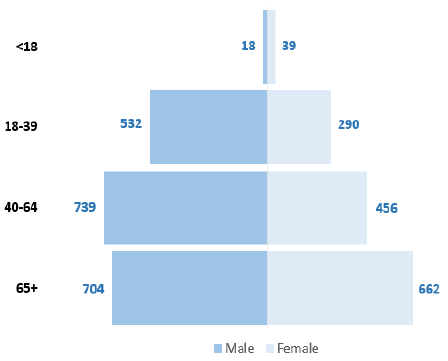
A total of 3,182 (92%) patients identified as being white in the 2018 Census with the majority desrcibing themselves as White Scottish. This is a 2 percentage point decrease on the 2017 Census and is 4% lower than the general population figure reported in Scotland's Census 2011, though Scotland's population will have changed in the 7 years since.
Table 9: Number of patients, by ethnicity and Census
| Patients by ethnicity | Census 2017 | Census 2018 | ||
|---|---|---|---|---|
| White Scottish | 2,880 | 81% | 2,674 | 78% |
| Other White | 474 | 13% | 508 | 15% |
| Asian, Asian Scottish or Asian British | 48 | 1% | 58 | 2% |
| African, African Scottish or African British | 19 | 1% | 21 | 1% |
| Other/multiple ethnic groups | 29 | 1% | 31 | 1% |
| Refused/Not Known | 122 | 3% | 151 | 4% |
| All | 3,572 | 100% | 3,443 | 100% |
Almost half (48%) of the patients in the 2018 Census have never been married, while 20% were currently married and a further 13% were widowed. This varied by age. Of those people who were married, 73% were aged 65 and over, while only 5% of married people were aged under 40.
The majority of patients (82%) did not have any dependents, while 5% had a working age adult (16-64 years old) dependent and 4% had a child(ren) aged 5-15 years old dependent.
The majority of patients were unemployed (45%) while 39% were retired. There were 132 patients (4%) who were employed, while 4% of patients were not allowed to work. In addition, 42 (1%) patients were students.
There were 1,290 (37%) of patients whose living circumstances at the Census were described as "Hospital or other medical establishment". A futher 714 (21%) patients were "Local Authority Tenants". Only 454 (13%) of patients in the 2018 Census owned their own home.
Contact
Email: Guy McGivern
There is a problem
Thanks for your feedback